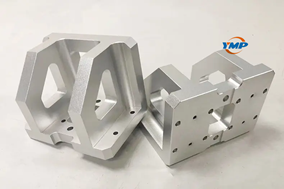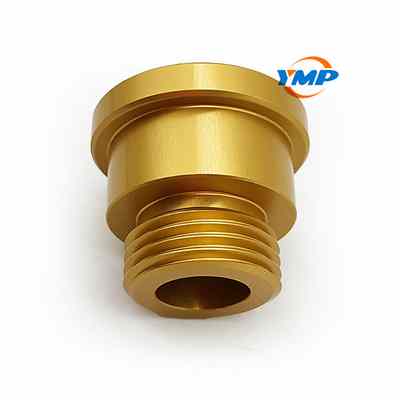In recent years, the rapid development of industrialization has put forward higher requirements for the overall processing level of the CNC processing industry, and there are also multiple considerations for the processing quality of aluminum parts. This also forces CNC aluminum parts processing factories to further improve aluminum parts to a certain extent. Processing workpiece quality.
Aluminum alloy CNC machining is a mechanical processing method that uses numerical control machine tools to process parts while using digital information to control the displacement of parts and tools.

First, the characteristics of CNC machining aluminum alloy
1. Low hardness of aluminum alloy
Compared with other metal materials, aluminum alloy has lower hardness, so it has good cutting performance, but at the same time, due to the low melting point and high ductility of this material, it is very easy to fuse on the finished surface or tool, and it is also It is easy to produce deficiencies such as glitches. Heat-treated or die-cast aluminum alloys also have higher hardness. Generally, the HRC hardness of aluminum plate is below 40 degrees, which is not a high hardness material. Therefore, during the processing of cnc aluminum parts, the load on the processing tool will be very small. In addition, the thermal conductivity of aluminum alloy is excellent, and the temperature required to complete the cutting of aluminum parts is low, which can greatly increase the milling speed.
2. The plasticity of aluminum alloy is low
"Plasticity" refers to the ability of a material to deform and expand continuously under the action of an external force during processing and deformation. The plasticity of aluminum alloy is mainly manifested in obtaining high elongation and low rebound rate. That is, it can undergo plastic deformation under the action of external force and maintain a certain degree of deformation.
The "plasticity" of aluminum alloys is generally affected by grain size. Grain size is a key factor affecting the plasticity of aluminum alloys. Generally speaking, the finer the grain, the better the plasticity of the aluminum alloy. This is because when the grains are finer, the number of dislocations generated during the processing of the material will be more, making the material easier to deform and have a higher degree of plasticity.
Aluminum alloy has low plasticity and low melting point. When CNC aluminum parts are processed, the chip removal performance is poor and the surface roughness is also high. This requires cnc processing factories to mainly solve the two problems of fixed blade and machined surface quality, which can solve the problem of aluminum alloy processing.
3. During the processing of aluminum parts, the tool is extremely easy to wear
During the machining of aluminum parts, the tool wear will be more serious due to the use of unsuitable tools, under the multiple influence of bar edge, cutting ejection problems. Therefore, before processing aluminum parts, you should choose a tool that can control the cutting temperature to the lowest level, and at the same time have a good rake surface roughness, and can smoothly discharge the cutting tool. Props with positive positive rake cutting edges and sufficient chip removal space are most suitable.
There are several ways to process aluminum parts:
1- Thermal processing.
This is a plastic forming process completed by feeding an aluminum alloy ingot above the recrystallization temperature; during hot working, the ingot has higher plasticity and lower deformation resistance, and can produce products with larger deformations with lesser-capacity equipment .

2. Cold processing
Cold working refers to the plastic forming process completed below the temperature that does not produce recovery and recrystallization. The essence of cold working is the combination process of cold working and intermediate annealing. Cold processing can produce final products with smooth surface, precise size, good tissue performance and meeting different performance requirements.
3- Warm processing
Warm working is a plastic forming process between cold working and hot working. The main purpose of warm working is to reduce the deformation resistance of metals and improve the plastic properties of metals.
Aluminum alloy processing should pay attention to the following items:
1-Aluminum profile temperature setting and control. Generally speaking, there is a certain error between the temperature and the surface temperature. When setting the surface temperature, it should be set according to the actual temperature of the equipment, and pay close attention to the fluctuation of the temperature.
2-Aluminum profile aging insulation. The aging should be set in strict accordance with the requirements of the processing technology, and the holding time should also be appropriate to prevent insufficient hardness due to insufficient or too long aging.
3- Aluminum extrusion frame should not be too dense, there must be gaps between materials, aluminum profiles, especially small and thick materials that are not ventilated, the gap needs to be larger, tube materials, small materials and sheet materials are assembled together When framed, the pipe material is put down to facilitate air circulation in time.
"Aging" in the processing of CNC aluminum parts refers to the heat treatment of aluminum alloys to achieve higher strength and hardness. After aluminum alloy parts go through many processes such as die-casting, processing, and annealing, the mechanical properties and tensile strength of the material will be insufficient due to the uneven grain size and distribution. "Aging" treatment means that after these processes, the material is reheated to a specific temperature and kept for a certain period of time, so that the grains in the material can be rearranged and form a uniform structure, thereby increasing the hardness and strength of the material.